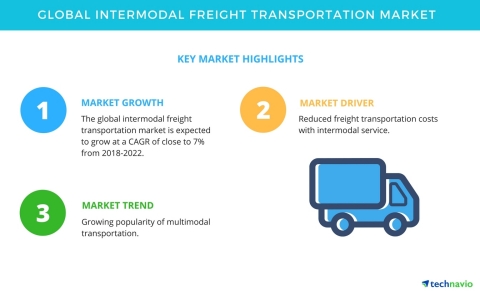LONDON--(BUSINESS WIRE)--The global intermodal freight transportation market is expected to grow at a CAGR of close to 7% during the period 2018-2022, according to a new market research study by Technavio.
The report presents a comprehensive research of the global intermodal freight transportation market based on product type (minerals and ores, food and farm products, equipment and instruments, chemicals, and others). The report also determines the geographic breakdown of the market in terms of detailed analysis and impact, which includes key geographies such as APAC, the Americas, and EMEA.
This report is available at a USD 1,000 discount for a limited time only: View market snapshot before purchasing
Save more with Technavio. Buy 2 reports and get the third for FREE: View all Technavio’s current offers
Market driver: reduced freight transportation costs with intermodal service
There is a high preference for intermodal freight transportation over single mode of transportation such as trucks owing to the cost advantages offered to shippers. The combination of using sea transportation to transport goods via seas or rivers and then using railways to transport the goods from ports, and then finally using road transportation for last mile delivery can save significant amount of cost compared with just using sea transportation and trucks for last mile delivery. It is observed that the cost of road freight carriers is rising. The cost of road freight transportation can be categorized mainly into fuel, labor, and equipment. Any change in the cost of these categories results in changes in the bottom line of road freight carriers.
“Owing to the increased costs, road freight companies look for opportunities to save money by using rails to transport goods on longer routes, which gives an opportunity for both buyers and freight forwarders to save on cost. Hence, the reduced freight costs owing to the use of different modes of transport while moving goods from one place to another are expected to drive the growth of the intermodal freight transportation market during the forecast period,” says a senior analyst at Technavio for transportation and distribution research.
Looking for more information on this market? Request a free sample report
Technavio’s sample reports are free of charge and contain multiple sections of the report including the market size and forecast, drivers, challenges, trends, and more.
Market trend: growing popularity of multimodal transportation
Both intermodal and multimodal transportation use multiple modes of transportation and are similar in most aspects, however, there is a clear distinguishing point between intermodal and multimodal transportation. Multimodal transportation is under a single contract, whereas intermodal transportation has multiple contracts with different carriers. Multimodal uses different modes of transport but under one single bill of lading. The same transport carrier is responsible for moving shipments in all different modes. This means a single company is responsible for the movement of goods across all modes of transport. The increasing convenience offered to shippers while transporting goods through multimodal transportation is expected to impede the growth of the intermodal freight transportation market in future.
Market challenge: high infrastructure cost
High investments in infrastructure are required to ship goods through intermodal transportation. Investments include the installation of gantry cranes and other heavy-duty cranes necessary to lift the cranes at different ports while changing the mode of transport. For example, whenever the container arrives at a sea port, it needs to be transferred to either a flat bed, rail, or a truck. Cranes are used to transfer containers from one mode of transportation to other. Also, necessary investments for rail and road access are also required. For example, a sea port should have a rail line so that railways can transport goods to and fro from the sea port. Similarly, roads are necessary so that trucks can easily access these ports.
Is your business on track for a successful future? Learn how Technavio can help
Technavio helps businesses anticipate changes in their marketplace, make proactive adjustments, and develop effective strategies to optimize their market positions.
|
Big savings with Technavio this February! Get 20% OFF on all Education Technology reports. This offer is valid only till the 28th of this month. |
About Technavio
Technavio is a leading global technology research and advisory company. Their research and analysis focuses on emerging market trends and provides actionable insights to help businesses identify market opportunities and develop effective strategies to optimize their market positions.
With over 500 specialized analysts, Technavio’s report library consists of more than 10,000 reports and counting, covering 800 technologies, spanning across 50 countries. Their client base consists of enterprises of all sizes, including more than 100 Fortune 500 companies. This growing client base relies on Technavio’s comprehensive coverage, extensive research, and actionable market insights to identify opportunities in existing and potential markets and assess their competitive positions within changing market scenarios.
If you are interested in more information, please contact our media team at media@technavio.com.




